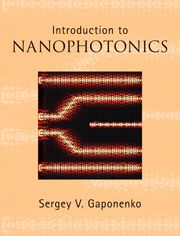Book contents
- Frontmatter
- Contents
- Preface
- Notations and acronyms
- 1 Introduction
- Part I Electrons and electromagnetic waves in nanostructures
- Part II Light–matter interaction in nanostructures
- 13 Light – matter interaction: introductory quantum electrodynamics
- 14 Density of states effects on optical processes in mesoscopic structures
- 15 Light–matter states beyond perturbational approach
- 16 Plasmonic enhancement of secondary radiation
- Author index
- Subject index
16 - Plasmonic enhancement of secondary radiation
from Part II - Light–matter interaction in nanostructures
Published online by Cambridge University Press: 05 June 2012
- Frontmatter
- Contents
- Preface
- Notations and acronyms
- 1 Introduction
- Part I Electrons and electromagnetic waves in nanostructures
- Part II Light–matter interaction in nanostructures
- 13 Light – matter interaction: introductory quantum electrodynamics
- 14 Density of states effects on optical processes in mesoscopic structures
- 15 Light–matter states beyond perturbational approach
- 16 Plasmonic enhancement of secondary radiation
- Author index
- Subject index
Summary
Nanostructures with characteristic surface relief of the order of 10–100 nm are known to modify the spatial distribution of an incident electromagnetic field. Local field enhancement results in enhanced absorption of photons by molecules or nanocrystals adsorbed at the surface. The effect is extremely pronounced in metal–dielectric structures because of surface plasmon resonance. A systematic application of field enhancement in Raman scattering enhancement and in photoluminescence enhancement with respect to molecular probes is followed nowadays by application of the effect with respect to nanocrystals (quantum dots) adsorbed at metal–dielectric nanotextured surfaces. It is the purpose of the present chapter to review mechanisms of photoluminescence enhancement and Raman scattering enhancement and factors in the context of their application to enhanced luminescence of molecules and quantum dots and Raman scattering. We consider not only local field enhancement in terms of the excitation process but also the photon density of states enhancement effect on photon emission processes with Raman scattering as a specific photon emission process. In this consideration, scattering of light experiences enhancement as does spontaneous emission. Therefore field enhancement and density of states effects should manifest themselves in the same manner in photoluminescence and scattering processes. Differences in scattering and luminescence enhancement are due to quenching processes which are crucial for luminescence and less pronounced for scattering.
- Type
- Chapter
- Information
- Introduction to Nanophotonics , pp. 436 - 454Publisher: Cambridge University PressPrint publication year: 2010



